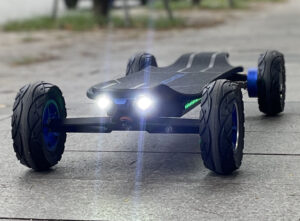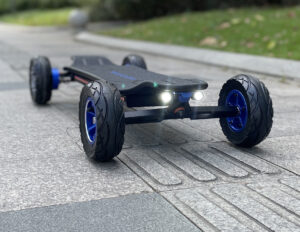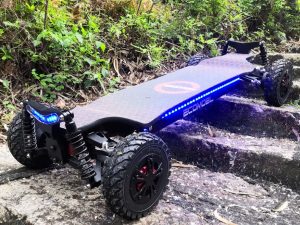Mountain boarding is an exhilarating sport that combines elements of snowboarding, skateboarding, and off-road biking. Riding a mountain board downhill can be an adrenaline-pumping experience, but it’s important to prioritize safety. In this guide, we will explore the essential steps and techniques to ride a mountain board safely downhill.
Choosing the Right Mountain Board
Choosing the Right Mountain Board is one of the most important factors in learning to safely ride downhill. The board size and shape you choose will dramatically affect your level of control and stability at higher speeds. For beginners, We recommend starting with a board around 33-35 inches, as anything smaller may feel too twitchy over rough terrain when learning to balance. The deck should have some flex to it for cushioning yet still feel sturdy under your feet. As for wheel size, softer compositions like 70mm 78A are best for getting a feel of carving and absorbing vibrations from the road. A sturdy pair of sideways-leaning reverse kingpin trucks provide adequate maneuverability without being so loose that they cause unwanted wobbles. Get the right gear set up from the start and you’ll be prepared for what’s to come as your skills progress.

Equipment Needed for Safety
Equipment Needed for Safety is so important when starting out mountain boarding. A certified helmet is not optional – it’s the easiest way to protect your most valuable asset. Given the speeds involved when bombing hills, an accident can result in serious injury without proper head protection. We also recommend armored gloves and knee/elbow pads, as they can save you from road rash in a fall and help build confidence as a beginner. Your joints and hands will thank you later on. Start by budgeting for good safety gear from reputable brands. It’s better to spend a bit extra here than end up with needless medical bills from an avoidable accident. Remember, there’s no point getting to the bottom of a mountain if you’re not in one piece to enjoy it and continue progressing your skills.
Learning Mountain Boarding Techniques
Learning Mountain Boarding Techniques properly is key before riding too fast or on steep terrain. Start by practicing your basic stance – keep your weight low and centered over the board for stability at higher speeds. Distribute your weight evenly between your front and back foot. Always keep your knees bent to absorb bumps and quickly shift your body weight for maneuvers. Learning controlled speed checks also takes repetition. On sloped roads, foot braking is best for slowing gradually in a straight line. Whereas sliding your foot perpendicular or angling the board is required for quick stops while turning. And carving is crucial for navigating curves. By mastering balanced turns on gradual grades, you’ll gain confidence in facing steeper challenges. Take time to hone your skills before progressing to more difficult conditions. Mastering core techniques first pays off with safety and improved handling later.

Finding Safe Areas to Practice Mountain Board
Finding Safe Areas to Practice is important when first starting out. Look for small, gradual downhill slopes without other users to work on your basics. Skate parks can also provide controlled environments. Get familiar with your board’s handling of simple terrain before taking on steeper challenges. As you progress, seek quiet neighborhood roads for carving turns. Always scan well ahead for potential obstacles like cracks, debris, other park visitors, and vehicles. Consider conditions like visibility, your physical abilities, and the terrain’s difficulty level. Avoid crowded multi-use trails until you’re confident riding at speed. You want to minimize variables and risks as a beginner. Also check the slope surface – softer ground like dirt or grass is safer than pavement for initial wiping out. Picking low-traffic, obstacle-free stretches is key until you build skills. Then you’ll be ready to progress to more technical paths.
Preparing Yourself for Downhill Riding
Preparing yourself physically and mentally is important for safe downhill mountain boarding. Be sure to do some warm-up exercises to get your muscles and joints ready for the stresses of riding. Jumping jacks, leg swings, and lunges can get your blood flowing and loosen you up. It’s also vital to prepare yourself mentally for riding downhill. Take some deep breaths and clear your mind of distractions so you can focus fully on the terrain and your riding. Having the right mental focus and readiness is key to properly assessing situations and handling your board with care at high speeds. Being physically and mentally prepared will help you greatly in maintaining control and riding confidently yet cautiously on steep downhill sections.

Safety Tips While Riding Downhill
Safety Tips While Riding Downhill are also core to keep in mind. Always consider your own ability and comfort level – there’s no shame in walking a section that feels too advanced. Control your speed within a margin of safety, and avoid distractions like phones or loud music. Being prepared in case you fall is crucial too. Tuck and roll to dissipate impact instead of fighting it, then quickly get out of any traffic paths. Communication and yielding also prevent collisions – always be respectful of other users’ right of way. If descending in a group, keep proper distances between riders adjusted for conditions and visibility. And know your terrain – have an escape route planned, like run-off sections, in case of unexpected obstacles. With focus, self-awareness, and courtesy, you’ll enjoy the thrill of boarding downhill safely for years to come. Progressive challenges will come naturally as your skills sharpen.
Conclusion
Building confidence and skills safely is key to enjoying mountain boarding in the long run. In conclusion, choosing the proper gear matched to your ability level and prioritizing protective safety equipment sets the right foundation. Develop core techniques on gentle slopes before tackling steeper runs. Finding controlled environments like skate parks or empty neighborhood roads lets you focus on fundamentals without stress. As competence grows, scope out quiet, obstacle-free trails to progress handling during descents. Self-awareness of limitations and terrain challenges, preparing for potential falls, yielding respectfully, and avoiding distractions are good habits for any rider. With a measured approach, focusing first on balance, controlled braking, and turn mastery, mountain boarding proves an accessible yet thrilling sport. And doing so intelligently means enjoying this progressive activity’s thrills for years to come in one piece. Now get out there, and happy, safe shredding!
FAQs
- Q: How do I turn effectively on a mountain board?
- Turning involves gradually shifting your weight from one foot to the other while leaning into the new edge. Practice S-turns on gentle slopes until the edges are natural.
- Q: What do I do if I start going too fast?
- The main braking method is dragging the toes of your back foot. You can also power-slide, stutter-step, or carve sharp toe-sides to slow down. Be prepared to bail by rolling if needed.
- Q: How do I prevent wrist pain from vibrations?
- Loosen your grip and keep your arms slightly bent to absorb trail feedback rather than gripping tightly. You can also try wrist guards or thicker mountain board gloves for added protection.
- Q: What’s the best way to fall safely?
- Try to fall to the side by rolling your body rather than bracing your arms or landing directly on your wrists, knees, or elbows. Protective pads under your gear help disperse impact forces from a fall.
- Q: How do I prevent ankle pain from riding?
- Strong ankles are important, so do exercises off the board. On steep runs, bend your knees more to take stress off your ankles. Take breaks if joints start to ache – pain is your body’s sign it needs rest. Proper fitting boots with good support also help.
Read More
- Electric Skateboards Vs Scooters – Ecomobl
- Electric Skateboard Wet Riding Maintenance – Ecomobl
- 6 Expert Tips For Electric Skateboarding – Ecomobl
- Electric Skateboards Safety Precautions – Ecomobl
- Beginners Electric Skateboards Guide – Ecomobl




